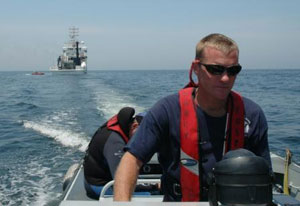| Sunday,
May 15, 2005
Greetings
from Gray’s Reef!
The day’s operations have started without a hitch…more
fish traps and dives are deployed.
 This morning, around 0800 hours, three dive crews board
the MonArk and other small motor boats and are taken by
the ship’s crew to their stations for more dives.
(picture to right)
After the boats are well away from the ship, the captain
motors over to our next survey location for three chevron
traps to be deployed. This time, Kevin is assisting Athan
and Sarah to help measure the fish. Athan anticipates
a much higher abundance in fish retrieved from the traps,
as well as increase in diversity because we are surveying
hard bottom (high relief) habitat for much of the day.
This morning, around 0800 hours, three dive crews board
the MonArk and other small motor boats and are taken by
the ship’s crew to their stations for more dives.
(picture to right)
After the boats are well away from the ship, the captain
motors over to our next survey location for three chevron
traps to be deployed. This time, Kevin is assisting Athan
and Sarah to help measure the fish. Athan anticipates
a much higher abundance in fish retrieved from the traps,
as well as increase in diversity because we are surveying
hard bottom (high relief) habitat for much of the day.
The differences in fish abundance and diversity in the
hard bottom area as compared to the sandy bottom are quite
remarkable. While the hard bottom area is extensive, it
is not continuous throughout the sanctuary. The rock comprising
the hard bottom (high relief) areas, on which the reef
grows, is made of mostly limestone that was deposited
two to five million years ago. These rocky outcrops rise
up to three meters (nine feet) from the sandy ocean floor.
The outcroppings, in many places, are separated by sandy,
flat-bottomed troughs which fish like the scup tend to
frequent.
The high relief areas of GRNMS provide a variety of habitats
for many of the fish and other animals in ocean. Additionally,
many of the animals prefer this environment because they
are more protected in a hard bottom area than in the sandy
bottom areas. One of Gray's Reef scientists claimed that
the plant and animal diversity found in Gray's Reef is
comparable to the diversity found in tropical rainforests.
I understand why these hard bottom areas in GRNMS are
popular fishing spots among local fishermen.
GRNMS is home to many different species of fish, both
pelagic (found in the open ocean) and benthic (found along
the ocean floor). These include black sea bass, snapper,
grouper, and mackerel. This great biodiversity is, in
part, the reason why the U.S. government identified Gray's
Reef as one of the most "nationally significant"
marine areas in 1981. Since that time, a management plan
was developed to pave the way for additional research
opportunities, like this one. The National Oceanic and
Atmospheric Administration, as well as other agencies
and organizations throughout the United States, hope that
with increased research experiences, the scientific community,
anglers, and the general public may grow to better understand
the dynamics within Grays Reef, and therefore, make sound
decisions about the sanctuary.
We have been blessed with another wonderful day of research
in Gray’s Reef.
Please
check back tomorrow to continue following our adventures
in the sanctuary.
Elizabeth
Gray’s
Reef National Marine Sanctuary:
Daily Connections to Scientific Inquiry & Nature of
Science
Start
Locally:
While
the ocean is vast and able to absorb many substances,
we can no longer treat it like a trash can where we dump
our waste. The nearest beach, barrier island, or marine
sanctuary may be hundreds or thousands of miles from us;
however, it is important that we protect them by:
·
Reduce our impact on the environment. Minimizing the amount
of waste we generate at home, school, work, etc. Avoid
purchasing items containing excessive packaging and support
the companies that have good environmental records. Reuse
and recycle household items and purchase recyclable items
from the store.
·
Get politically active. Before becoming law, many ocean
and coastal issues require approval of a proposal by a
majority of voters. National and international issues
still require a “majority rule”, so get your
vote out there. Conduct research. Many political issues
involve the ocean yet do not explicitly address it such
as excess carbon dioxide in the atmosphere. It is possible
that we will be called upon to vote whether the United
States should spend large amounts of government funds
to add iron in our oceans to reduce the carbon dioxide.
Learn
more about the ocean. Studying our world as a dynamic
system, comprised of the hydrosphere, biosphere, atmosphere,
and geosphere, helps scientists understand how one sphere
interacts with and affects the others. Our surveys to
GRNMS are perfect examples of scientists researching the
interaction among the hydrosphere, geosphere, and biosphere.
|







